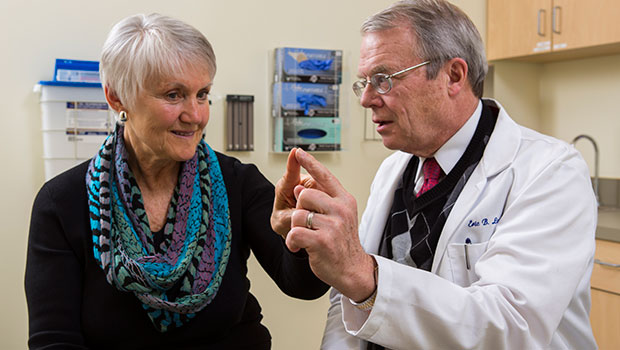Dementia is developing in a smaller proportion of older Americans over time
Trend tied to more education, physical activity, and controlling heart risks, say Dr. Eric B. Larson and University of Michigan team
Content creator: University of Michigan Health System
ANN ARBOR, Mich.—In a hopeful sign for the health of the nation’s brains, the percentage of American seniors with dementia is dropping, a new study finds: “A Comparison of the Prevalence of Dementia in the United States in 2000 and 2012” in JAMA Internal Medicine.
The downward trend has emerged despite something else the study shows: a rising tide of three factors that are thought to raise dementia risk by interfering with brain blood flow, namely diabetes, high blood pressure and obesity.
Those with the most years of education had the lowest chances of developing dementia, according to the findings. This may help explain the larger trend, because today’s seniors are more likely to have at least a high school diploma than those in the same age range a decade ago.
The findings were published by a team from the University of Michigan (U-M) that also includes Eric B. Larson, MD, MPH, the executive director of Group Health Research Institute and Group Health’s vice president for research. You can read a blog by Dr. Larson here: “Dementia Study Has Good News: Prevalence Declines Even as Population Ages.”
With the largest generation in American history now entering the prime years for dementia onset, the new results add to a growing number of recent studies in the United States and other countries that suggest a downward trend in dementia prevalence. These findings may help policymakers and economic forecasters adjust their predictions for the total impact of Alzheimer’s disease and other conditions.
“Our results, based on in-depth interviews with seniors and their caregivers, add to a growing body of evidence that this decline in dementia risk is a real phenomenon, and that the expected future growth in the burden of dementia may not be as extensive as once thought,” says lead author Kenneth Langa, MD, PhD, a professor in the U-M Medical School, Institute for Social Research and School of Public Health, and a research investigator at the VA Ann Arbor Healthcare System.
“A change in the overall dementia forecast can have a major economic impact,” he adds. “But it does nothing to lessen the impact that each case has on patients and caregivers. This is still going to be a top priority issue for families, and for health policy, now and in the coming decades.”
Nearly three-point drop
Dr. Langa and colleagues used data and cognitive test results from ISR’s long-term Health and Retirement Study to evaluate trends from 2000 to 2012 among a nationally representative sample of more than 21,000 people age 65 or older.
In all, 11.6 percent of those interviewed in 2000 met the criteria for dementia, while in 2012, only 8.8 percent did. Over that time, the average number of years of education a senior had rose by nearly an entire year, from 12 to 13.
“It does seem that the investments this country made in education after the Second World War are paying off now in better brain health among older adults,” says David R. Weir, PhD, senior author of the paper and director of the Health and Retirement Study. “But the number of older adults is growing so rapidly that the overall burden of dementia is still going up.”
Even as these new results come out, the Health and Retirement Study team is in the middle of another large study of dementia in the U.S. that will help refine the techniques for better understanding who has dementia in the American population, and allow them to be used in other countries around the world where HRS “sister studies” are also collecting data.
Dr. Langa, who is the Sturgis Professor of Internal Medicine and a member of the U-M Institute for Healthcare Policy and Innovation, notes that the differences in dementia risk according to education level mark an important health disparity now, and likely into the future.
“More baby boomers have completed some higher education than any previous generation, but the trend toward more education appears to be leveling off in the U.S. And there are clear disparities in educational attainment according to wealth and ethnicity,” he says. “These differences in education and wealth may actually be creating disparities in brain health and, by extension, the likelihood of being able to work and be independent in our older years.”
Years of formal education was the only marker tracked among the study participants. But, says Langa, it is likely that the other ways that people challenge and use their brains throughout life—reading, social interactions, what occupation they have, and how long they work—may also have an impact on dementia risk in later life.
All of these pursuits can help build up a person’s “cognitive reserve” of brain pathways that can survive the assault of the physical factors that lead to dementia.
Next steps
Researchers hope to learn much more about the cognitive reserve concept with new funding from recent federal initiatives that aim to increase dementia-related research and discovery.
Continued focus on reducing cardiovascular risk—through increased physical activity and controlling hypertension and diabetes in younger and middle-aged people—may also help reduce future dementia rates.
Growing evidence has shown that dementia in older adults is usually due to multiple causes. That includes Alzheimer’s disease, which is characterized by a buildup of abnormal proteins in the brain, as well as vascular dementia, which results from brain tissue not receiving enough blood due to blockages and leaks in the brain’s blood vessels.
For those who do develop dementia, Dr. Langa notes, the challenge for America going forward will be to address the need for long-term care at home and in institutions, in the face of smaller families with fewer members to act as caregivers.
Even if the slide in dementia incidence continues, the baby boom generation’s sheer size will mean challenges for those who fund care or provide it.
In addition to Drs. Langa, Weir, and Larson, the study’s authors are Eileen M. Crimmins, PhD, of the University of Southern California, and University of Michigan researchers Jessica D. Faul, PhD, Deborah A. Levine, MD, MPH, and Mohammed Kabeto, MS.
The study was funded by the National Institute on Aging of the National Institutes of Health (AG00974, AG040278, AG053760, AG024824).
Reference: JAMA Internal Medicine, 2017:177(1):1-9. Doi:10.1001/jamainternmed.2016.6807.
About Kaiser Permanente
Kaiser Permanente is committed to helping shape the future of health care. We are recognized as one of America’s leading health care providers and not-for-profit health plans. Founded in 1945, Kaiser Permanente has a mission to provide high-quality, affordable health care services and to improve the health of our members and the communities we serve. We currently serve more than 12.4 million members in eight states and the District of Columbia. Care for members and patients is focused on their total health and guided by their personal Permanente Medical Group physicians, specialists and team of caregivers. Our expert and caring medical teams are empowered and supported by industry-leading technology advances and tools for health promotion, disease prevention, state-of-the-art care delivery and world-class chronic disease management. Kaiser Permanente is dedicated to care innovations, clinical research, health education and the support of community health. For more information, go to: kp.org/share.
Healthy findings blog

Dementia study has good news: Prevalence declines even as population ages
Better education and cardiovascular health may be key. This means hope for reducing risk through social determinants and lifestyle, says Dr. Eric B. Larson.
Read it in Healthy Findings.
for immediate release
Media contact
For more on Kaiser Permanente Washington Health Research Institute news, please contact:
Bianca DiJulio
bianca.s.dijulio@kp.org
206-660-8333
After-hours media line: 206-448-4056


